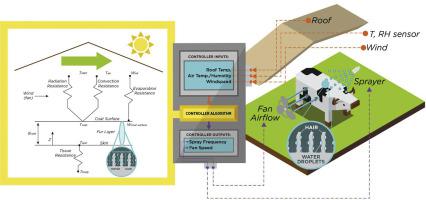当前位置:
X-MOL 学术
›
Biosyst. Eng.
›
论文详情
Our official English website, www.x-mol.net, welcomes your
feedback! (Note: you will need to create a separate account there.)
Transient simultaneous heat and mass transfer model to estimate drying time in a wetted fur of a cow
Biosystems Engineering ( IF 4.4 ) Pub Date : 2020-07-01 , DOI: 10.1016/j.biosystemseng.2020.04.011 Elizabeth Chen , Vinod Narayanan , Theresa Pistochini , Erfan Rasouli
Biosystems Engineering ( IF 4.4 ) Pub Date : 2020-07-01 , DOI: 10.1016/j.biosystemseng.2020.04.011 Elizabeth Chen , Vinod Narayanan , Theresa Pistochini , Erfan Rasouli

|
To reduce heat stress that contributes to complications in milk production and breeding, dairy cows are typically cooled by intermittent water sprays coupled with fan-induced air flow. Industry currently utilises fixed duration on and off-cycles; however, water efficiency may be improved by matching the sprinkler off-time to the cow drying time that corresponds to current outdoor environmental conditions. Electricity use can also be reduced by varying fan speeds to achieve the required heat rejection rate for a given set of conditions. To achieve savings in water and electricity, a transient, one-dimensional simultaneous heat and mass transfer model of evaporation within the wetted fur layer of a dairy cows was developed to estimate drying time and heat rejection rate based on ambient conditions. Water vapour concentration, liquid water content, and temperature within the fur layer were used to estimate a global drying time for fur. Model results was compared against a steady-state model in literature and the predicted net heat load is within 15% with a mean average error of 6.0%. Parametric analyses were performed to estimate drying time as a function of outdoor air temperature, air speed, humidity, and mean radiant temperature. Simulation results were used to develop a correlation for use in a control algorithm to predict the fan speed and sprinkler operation frequency needed to meet specified cooling load thresholds given outdoor conditions. Estimated savings demonstrated that the model-based controller could reduce annual electricity and water consumption by 20% and 40%, respectively.
中文翻译:

瞬态同时传热和传质模型,用于估计牛湿毛皮的干燥时间
为了减少导致产奶和育种并发症的热应激,奶牛通常通过间歇性喷水和风扇引起的气流冷却。行业目前使用固定持续时间的开启和关闭周期;然而,通过将喷水器关闭时间与对应于当前室外环境条件的奶牛干燥时间相匹配,可以提高用水效率。还可以通过改变风扇速度来减少电力使用,以实现给定条件下所需的排热率。为了节省水和电,我们开发了奶牛湿毛层内蒸发的瞬态、一维同时传热和传质模型,以根据环境条件估算干燥时间和排热率。水蒸气浓度、液态水含量、毛皮层内的温度和温度用于估计毛皮的整体干燥时间。模型结果与文献中的稳态模型进行比较,预测净热负荷在 15% 以内,平均误差为 6.0%。进行参数分析以估计作为室外空气温度、风速、湿度和平均辐射温度的函数的干燥时间。模拟结果用于开发相关性,以用于控制算法,以预测在给定室外条件下满足指定冷却负载阈值所需的风扇速度和喷水器操作频率。估计的节省表明,基于模型的控制器可以分别减少 20% 和 40% 的年度电力和水消耗。模型结果与文献中的稳态模型进行比较,预测净热负荷在 15% 以内,平均误差为 6.0%。进行参数分析以估计作为室外空气温度、空气速度、湿度和平均辐射温度的函数的干燥时间。模拟结果用于开发相关性,以用于控制算法,以预测在给定室外条件下满足指定冷却负载阈值所需的风扇速度和喷水器操作频率。估计的节省表明,基于模型的控制器可以分别减少 20% 和 40% 的年度电力和水消耗。模型结果与文献中的稳态模型进行比较,预测净热负荷在 15% 以内,平均误差为 6.0%。进行参数分析以估计作为室外空气温度、空气速度、湿度和平均辐射温度的函数的干燥时间。模拟结果用于开发相关性,以用于控制算法,以预测在给定室外条件下满足指定冷却负载阈值所需的风扇速度和喷水器操作频率。估计的节省表明,基于模型的控制器可以分别减少 20% 和 40% 的年度电力和水消耗。进行参数分析以估计作为室外空气温度、空气速度、湿度和平均辐射温度的函数的干燥时间。模拟结果用于开发相关性,以用于控制算法,以预测在给定室外条件下满足指定冷却负载阈值所需的风扇速度和喷水器操作频率。估计的节省表明,基于模型的控制器可以分别减少 20% 和 40% 的年度电力和水消耗。进行参数分析以估计作为室外空气温度、风速、湿度和平均辐射温度的函数的干燥时间。模拟结果用于开发相关性,以用于控制算法,以预测在给定室外条件下满足指定冷却负载阈值所需的风扇速度和喷水器操作频率。估计的节省表明,基于模型的控制器可以分别减少 20% 和 40% 的年度电力和水消耗。
更新日期:2020-07-01
中文翻译:

瞬态同时传热和传质模型,用于估计牛湿毛皮的干燥时间
为了减少导致产奶和育种并发症的热应激,奶牛通常通过间歇性喷水和风扇引起的气流冷却。行业目前使用固定持续时间的开启和关闭周期;然而,通过将喷水器关闭时间与对应于当前室外环境条件的奶牛干燥时间相匹配,可以提高用水效率。还可以通过改变风扇速度来减少电力使用,以实现给定条件下所需的排热率。为了节省水和电,我们开发了奶牛湿毛层内蒸发的瞬态、一维同时传热和传质模型,以根据环境条件估算干燥时间和排热率。水蒸气浓度、液态水含量、毛皮层内的温度和温度用于估计毛皮的整体干燥时间。模型结果与文献中的稳态模型进行比较,预测净热负荷在 15% 以内,平均误差为 6.0%。进行参数分析以估计作为室外空气温度、风速、湿度和平均辐射温度的函数的干燥时间。模拟结果用于开发相关性,以用于控制算法,以预测在给定室外条件下满足指定冷却负载阈值所需的风扇速度和喷水器操作频率。估计的节省表明,基于模型的控制器可以分别减少 20% 和 40% 的年度电力和水消耗。模型结果与文献中的稳态模型进行比较,预测净热负荷在 15% 以内,平均误差为 6.0%。进行参数分析以估计作为室外空气温度、空气速度、湿度和平均辐射温度的函数的干燥时间。模拟结果用于开发相关性,以用于控制算法,以预测在给定室外条件下满足指定冷却负载阈值所需的风扇速度和喷水器操作频率。估计的节省表明,基于模型的控制器可以分别减少 20% 和 40% 的年度电力和水消耗。模型结果与文献中的稳态模型进行比较,预测净热负荷在 15% 以内,平均误差为 6.0%。进行参数分析以估计作为室外空气温度、空气速度、湿度和平均辐射温度的函数的干燥时间。模拟结果用于开发相关性,以用于控制算法,以预测在给定室外条件下满足指定冷却负载阈值所需的风扇速度和喷水器操作频率。估计的节省表明,基于模型的控制器可以分别减少 20% 和 40% 的年度电力和水消耗。进行参数分析以估计作为室外空气温度、空气速度、湿度和平均辐射温度的函数的干燥时间。模拟结果用于开发相关性,以用于控制算法,以预测在给定室外条件下满足指定冷却负载阈值所需的风扇速度和喷水器操作频率。估计的节省表明,基于模型的控制器可以分别减少 20% 和 40% 的年度电力和水消耗。进行参数分析以估计作为室外空气温度、风速、湿度和平均辐射温度的函数的干燥时间。模拟结果用于开发相关性,以用于控制算法,以预测在给定室外条件下满足指定冷却负载阈值所需的风扇速度和喷水器操作频率。估计的节省表明,基于模型的控制器可以分别减少 20% 和 40% 的年度电力和水消耗。









































 京公网安备 11010802027423号
京公网安备 11010802027423号